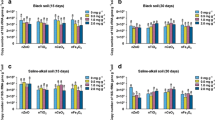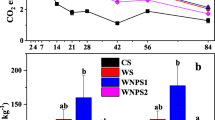Abstract
TiO2 nano particles (NPs) are one of the most produced nanoparticles in the world which are increasingly being released in to the soil. Soils are exposed to various level of concentration of TiO2 NPs, which has raised concern over the adverse influence on soil microbial community, in turn on ecosystem functions. Although, increasing number of studies on ecotoxicological effect of TiO2 NPs are coming up recently, however, a common conscience has yet to be reached regarding the impact of TiO2 NPs on soil microbial community and processes. Moreover, very few studies have targeted soil enzymes which are being considered as sensitive indicator of soil health. Therefore, the present study has been carried out to estimate the ecotoxicological effect of various doses of TiO2 NPs (5, 10, 20, 40, 80, 100 mg kg−1 soil) on different soil enzymes and microbial community structure. Results revealed that soil enzyme activities and microbial biomass had a uniform trend where the value increased up to the dose of 20 mg TiO2 NPs kg−1 soil and there onwards reduced drastically up to 100 mg TiO2 NPs kg−1 soil dose. On the contrary, soil respiration and metabolic quotient kept increasing up to 100 mg TiO2 NPs kg−1 soil dose indicating sub-lethal stress on microbial community. Nevertheless, the structure of microbial community had slightly different trend where the biomass of total phospho lipid fatty acid (PLFA), Gram positive, Gram negative bacteria, fungi, actinomyctetes and anaerobes were found to be increased up to dose of 80 mg TiO2 NPs kg−1 soil, but, significantly declined at 100 mg TiO2 NPs kg−1 soil dose. Furthermore, temperature effect on TiO2 NPs toxicity had exhibited a less negative impact at 40 °C rather than at 25 °C. In addition alteration index (AI3), an integrated indicator of C, N, P cycling of soils as well as a well-documented indicator of soil pollution, has been found to be regulated by soil respiration, clay content, anaerobe and eukaryote for AI3-Acid Phos. and by fungi to bacteria ratio, soil respiration, microbial biomass and Gram positive bacteria for AI3-Alk. Phos. Overall, the study provided valuable information regarding ecotoxicological impact of environmentally relevant concentrations of TiO2 NPs in clay loam soils as well as improved our perception regarding the impact of NPs on soil functioning.





Similar content being viewed by others
Data availability
All data generated or analysed during this study are included in this published article and its supplementary information files.
References
Adam G, Duncan H (2001) Development of a sensitive and rapid method for the measurement of total microbial activity using fluorescein diacetate (FDA) in a range of soils. Soil Biol Biochem 33(7):943–951
Adhikari T, Sarkar D, Mashayekhi H, Xing B (2015) Growth and enzymatic activity of maize (Zea mays L.) plant: solution culture test for copper dioxide nano particles. J Plant Nutr, https://doi.org/10.1080/01904167.2015.1044012
Anderson TH, Domsch KH (1993) The metabolic quotient for CO2 (qCO2) as a specific activity parameter to assess the effects of environmental conditions, such as pH, on the microbial biomass of forest soils. Soil Biol Biochem 25:393–395
Anderson JPE (1982) Soil respiration. In: Page AL, et al., eds. Methods of soil analysis. Part 2. Chemical and microbiological properties, 2nd ed. Agronomy Monograph 9. ASA and SSSA, Madison, WI, p 837–871
Auffan DM, Santaella DC, Thiéry PA, Paillès C, Rose J, Achouak DW, Thill DA, Masion A, Wiesner M, Bottero JY (2012) Ecotoxicity of inorganic nanoparticles: from unicellular organisms to invertebrates. In: Bhushan PB (Ed.) Encyclopedia of nanotechnology. Springer, Netherlands, p 623–636
Bhattacharjya S, Bhaduri D, Chauhan S, Chandra R, Raverkar KP, Pareek N (2017b) Comparative evaluation of three contrasting land use systems for soil carbon, microbial and biochemical indicators in North-Western Himalaya. Ecol Eng 103:21–30
Bhattacharjya S, Chandra R, Pareek N, Raverkar KP (2016) Biochar and crop residue application to soil: effect on soil biochemical properties, nutrient availability and yield of rice (Oryza sativa L.) and wheat (Triticum aestivum L.). Arch Agron Soil Sci 62(8):1095–1108
Bhattacharjya S, Chandra R, Sharma MP, Sharma SK, Agnihotri R (2017a) Biochar and crop residue amendments on soil microbial and biochemical properties. Proc Natl Acad Sci India Sect B Biol Sci 87(3):975–983
Caldwell BA (2005) Enzyme activities as a component of soil biodiversity: a review. Pedobiologia 49:637–644
Chai H, Yao J, Sun J, Zhang C, Liu W, Zhu M, Ceccanti B (2015) The effect of metal oxide nanoparticles on functional bacteria and metabolic profiles in agricultural. Soil Bull Environ Contam Toxicol 94:490–495
Cheng Z, Tan ALK, Tao Y, Shan D, Ting KE, Yin XJ (2012) Synthesis and characterization of iron oxide nanoparticles and applications in the removal of heavy metals from industrial waste water. Intl J Photoener 5. https://doi.org/10.1155/2012/608298
Dinesh R, Anandaraj M, Srinivasan V, Hamza S (2012) Engineered nanoparticles in the soil and their potential implications to microbial activity. Geoderma 173–174:19–27
Doran JW, Zeiss MR (2000) Soil health and sustainability: managing the biotic component of soil quality. Appl Soil Ecol 15:3–11. https://doi.org/10.1016/s0929-1393(00)00067-6
Du W, Sun Y, Ji R, Zhu J, Wu J, Guo H (2011) TiO2 and ZnO nanoparticles negatively affect wheat growth and soil enzyme activities in agricultural soil. J Environ Monit 13:822–828
Fang X, Yu R, Li B, Somasundaran P, Chandran K (2010) Stresses exerted by ZnO, CeO2 and anatase TiO2 nanoparticles on the Nitrosomonas europaea. J Colloid Interface Sci 348(2):329–334. https://doi.org/10.1016/j.jcis.2010.04.075
Frostegård Å, Bååth E, Tunlid A (1993) Shifts in the structure of soil microbial communities in limed forests as revealed by phospholipid fatty acid analysis. Soil Biol Biochem 25:723–730
Gardea-Torresdey JL, Rico CM, White JC (2014) Trophic transfer, transformation, and impact of engineered nanomaterials in terrestrial environments. Environ Sci Technol 48:2526–2540
Ge Y, Schimel JP, Holden PA (2011) Evidence for negative effects of TiO2 and ZnO nanoparticles on soil bacterial communities. Environ Sci Technol 45:1659–1664
Ge Y, Schimel JP, Holden PA (2012) Identification of soil bacteria susceptible to TiO2 and ZnO nanoparticles. Appl Environ Microbiol 78:6749–6758
Ghosh A, Singh AB, Kumar RV, Manna MC, Bhattacharyya R, Rahman MM, Sharma P, Rajput PS, Misra S (2019) Soil enzymes and microbial elemental stoichiometry as bio-indicators of soil quality in diverse cropping systems and nutrient management practices of Indian Vertisols. Appl Soil Ecol 145:103304
Gogos A, Knauer K, Bucheli TD (2012) Nanomaterials in plant protection and fertilization: current state, foreseen applications, and research priorities. J Agric Food Chem 60:9781–9792
Hänsch M, Emmerling C (2010) Effects of silver nanoparticles on the microbiota and enzyme activity in soil. J Plant Nutr Soil Sci 173:554–558
Hinojosa MB, Carreira JA, García-Ruíz R, Dick RP (2004) Soil moisture pre-treatment effects on enzyme activities as indicators of heavy metal-contaminated and reclaimed soils Soil Biol Biochem 36:1559–1568
Hotze EM, Phenrat T, Lowry GV (2010) Nanoparticle aggregation: challenges to understanding transport and reactivity in the environment. J Environ Qual 39:1909
Hou J, Wang L, Wang C, Zhang S, Liu H, Li S, Wang X (2018) Toxicity and mechanisms of action of titanium dioxide nanoparticles in living organisms. J Environ Sci 75:40–53
Jośko I, Oleszczuk P, Futa B (2014) The effect of inorganic nanoparticles (ZnO, Cr2O3, CuO and Ni) and their bulk counterparts on activities in different soils. Geoderma 232–234:528–537
Keller AA, McFerran S, Lazareva A, Suh S (2013) Global life cycle releases of engineered nanomaterials. J Nanopart Res 15:1–17. https://doi.org/10.1007/s11051-013-1692-4
Khosravi-katuli K, Prato E, Lofrano G, Guida M (2017) Effects of nanoparticles in species of aquaculture interest. Environ Sci Pollut Res 24:17326–17346
Lowry GV, Gregory KB, Apte SC, Lead JR (2012) Transformations of nanomaterials in the environment. Environ Sci Technol 46:6893–9
Ma S, Lin D (2013) The biophysicochemical interactions at the interfaces between nanoparticles and aquatic organisms: adsorption and internalization. Environ Sci Processes Impacts 15:145
Minetto D, Ghirardini MAV, Libralato G (2016) Saltwater ecotoxicology of Ag, Au, CuO, TiO2, ZnO and C 60 engineered nanoparticles: an overview. Environ Int 92:189–201
Nowack B, Bucheli TD (2007) Occurrence, behavior and effects of nanoparticles in the environment. Environ Pollut 150(1):5–22. https://doi.org/10.1016/j.envpol.2007.06.006
Padhan K, Bhattacharjya S, Sahu A, Manna MC, Sharma MP, Singh M, Wanjari R, Sharma RP, Sharma GK, Patra AK (2020) Soil N transformation as modulated by soil microbes in a 44 years long term fertilizer experiment in a sub-humid to humid Alfisol. Appl Soil Ecol 145:103355
Pawlett M, Ritz K, Dorey RA, Rocks S, Ramsden J, Harris JA (2013) The impact of zero-valent iron nanoparticles upon soil microbial communities is context dependent. Environ Sci Pollut Res 20:1041–1049
Puglisi E, Del Re AAM, Rao MA, Gianfreda L (2006) Development and validation ofnumerical indexes integrating enzyme activities of soils. Soil Biol Biochem 38:1673–1681
Scheffer F, Schachtschabel P, Blume HP, Brümmer GW, Schwertmann U, Horn R, Kögel-Knabner I, Stahr KBMW (2002) Scheffer/Schachtschabel: Lehrbuch der Bodenkunde. Spektrum Akademischer Verlag GmbH, Heidelberg, Berlin
Schimel JP, Schaeffer SM (2012) Microbial control over carbon cycling in soil. Front Microbiol. https://doi.org/10.3389/fmicb.2012.00348
Simonin M, Guyonnet JP, Martins JMF, Ginot M, Richaume A (2015) Influence of soil properties on the toxicity of TiO2 nanoparticles on carbon mineralization and bacterial abundance. J Hazard Mater 283:529–35
Simonin M, Martins JM, Le Roux X, Uzu G, Calas A, Richaume A (2017) Toxicity of TiO2 nanoparticles on soil nitrification at environmentally relevant concentrations: Lack of classical dose-response relationships. Nanotoxicology 11(2):247–255. https://doi.org/10.1080/17435390.2017.1290845
Slavin YN, Asnis J, Häfeli UO et al. (2017) Metal nanoparticles: understanding the mechanisms behind antibacterial activity. J Nanobiotechnol 15:65. https://doi.org/10.1186/s12951-017-0308-z
Sun Y-P, Li X-q, Cao J, Zhang W-x, Wang HP (2006) Characterisation of zero-valent iron nanoparticles Adv Colloid Inter Sci 120:47–56. https://doi.org/10.1016/j.cis.2006.03.001
Wang H, Adeleye AS, Huang Y, Li F, Keller AA (2015) Heteroaggregation of nanoparticles with biocolloids and geocolloids. Adv Coll Interface Sci 226:24–36
Zhai Y, Hunting ER, EliseBaas GL, Willie JGM, Peijnenburg WJGM, Vijver MJ (2019) Compositional alterations in soil bacterial communities exposed to TiO2 nanoparticles are not reflected in functional impacts. Environ Res 178:108713
Zhao J, Wang Z, White JC, Xing B (2014) Graphene in the aquatic environment: adsorption, dispersion, toxicity and transformation. Environ Sci Technol 48:9995–10009
Zhu JJ, Xu YQ, He JH, Yu HP, Huang CJ, Gao JM, Li CQ (2014) Human cardiotoxic drugs delivered by soaking and microinjection induce cardiovascular toxicity in zebrafish. J Appl Toxicol 34(2):139–148. https://doi.org/10.1002/jat.2843
Acknowledgements
Financial support provided by the CRP Platform of Nanotechnology, Indian Council of Agricultural Research, New Delhi, India is duly acknowledged.
Funding
CRP Platform of Nanotechnology, Indian Council of Agricultural Research, New Delhi,
Author contributions
SB conceptualized and executed the experiment, analyzed the soil samples for different soil parameters, processed and interpreted the data and prepared the manuscript. TA conceptualized and executed the experiment, analysed the soil samples for different soil parameters, processed and interpreted the data. AS contributed in data processing, result interpretation and manuscript preparation. AKP edited and corrected the final draft of the manuscript.
Author information
Authors and Affiliations
Corresponding author
Ethics declarations
Conflict of interest
The authors declare no competing interests.
Additional information
Publisher’s note Springer Nature remains neutral with regard to jurisdictional claims in published maps and institutional affiliations.
Supplementary information
Rights and permissions
About this article
Cite this article
Bhattacharjya, S., Adhikari, T., Sahu, A. et al. Ecotoxicological effect of TiO2 nano particles on different soil enzymes and microbial community. Ecotoxicology 30, 719–732 (2021). https://doi.org/10.1007/s10646-021-02398-2
Accepted:
Published:
Issue Date:
DOI: https://doi.org/10.1007/s10646-021-02398-2




